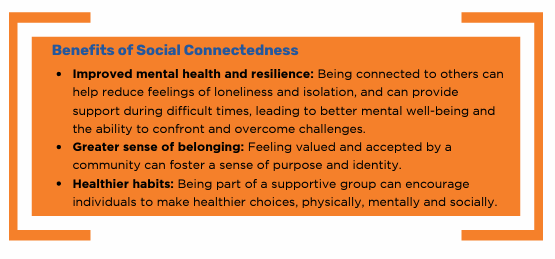The Importance of Social Connectedness
A child’s community plays a critical role in fostering their growth. For children to truly thrive, they need safe, responsive connections with caring adults. When the adults in their lives have their own needs met, they’re better equipped to respond to the social and emotional needs of their kids.
According to the Centers for Disease Control and Prevention, social connectedness is defined as the relationships people or groups have, which lead to a sense of belonging, being cared for, valued, and supported. When individuals are socially connected, they are better able to navigate life challenges and cope with stress, trauma, adversity, anxiety, and depression.
The Toll of Social Isolation
Social isolation is the absence of connectedness to people, community, and therefore, influence and power. Social isolation creates barriers to developing supportive relationships and communities, sharing personal and communal experiences, or forming part of the bigger whole that can build a sense of individual and collective identity.
The toll of social isolation has been shown in recent studies in which nearly 1 in 4 Wisconsinites report that they only sometimes or never get the social and emotional support they need; and only 4 in 10 American adults said that they feel very connected to others in 2022. Even more troubling, caregivers of children, especially mothers and single parents, are more likely to experience feelings of loneliness.
So, what is causing the increased social isolation across our communities? A few examples:
- Declines in meaningful connection, trust and membership in religious groups, social clubs, and labor unions due to the increase in use of smart phones, social media, remote work and political polarization;
- Disruption of communities due to loss of industries such as farming and manufacturing;
- Increased demands on lower-wage earners’ time and energy due to working longer hours and having less money to spend on transportation, social activities, etc.
When we are socially isolated, our health becomes vulnerable to heart attacks, dementia, depression, and early death. Recent studies have compared its impact to smoking nearly a pack of cigarettes a day. Additionally, when caregivers are socially isolated, they are less likely to have the coping skills AND community such as family and friends to support them when they become overloaded by stress. In these critical moments, children become vulnerable to neglect.
The Path to Social Connectedness
How might we strengthen social connectedness for our communities, caregivers, and children? Social connectedness occurs through family, school, work, and recreational and faith communities. More formally, it occurs through community and cultural events, support groups, and social services. Strengthening social infrastructure is crucial for enhancing community health, resilience, safety, and prosperity.
The goal of SFTCCC is to create and support a movement that shares knowledge and strategies, elevates one another’s efforts, and collaborates intentionally to co-design and advance policy and practice solutions that prevent and reduce social isolation by refocusing our efforts on building community and strengthening social connectedness for families, so that we may reduce family separations for reasons of neglect.

